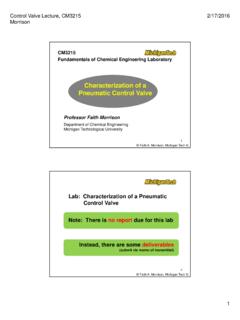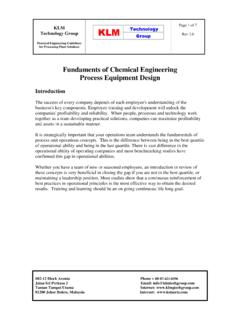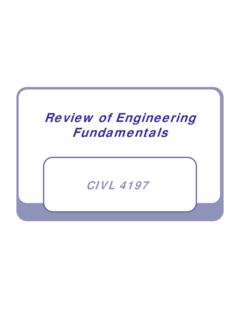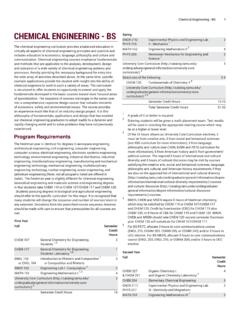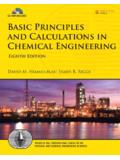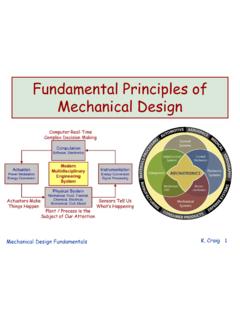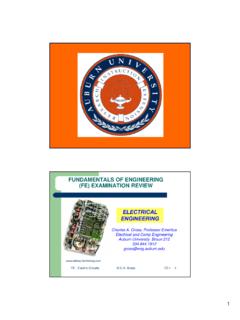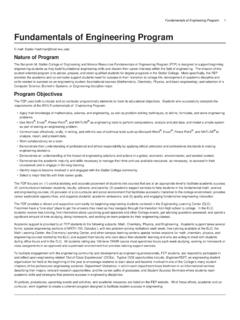Transcription of Fundamentals of Chemical Engineering …
1 Fundamentals of Chemical EngineeringThermodynamicsFundamentals of Chemical EngineeringThermodynamicsThemis MatsoukasUpper Saddle River, NJ Boston Indianapolis San FranciscoNew York Toronto Montreal London Munich Paris MadridCapetown Sydney Tokyo Singapore Mexico CityMany of the designations used by manufacturers and sellers to distin-guish their products are claimed as trademarks. Where those designa-tions appear in this book, and the publisher was aware of a trademarkclaim, the designations have been printed with initial capital letters orin all author and publisher have taken care in the preparation of thisbook, but make no expressed or implied warranty of any kind and assumeno responsibility for errors or omissions.
2 No liability is assumed for inci-dental or consequential damages in connection with or arising out of theuse of the information or programs contained publisher offers excellent discounts on this book when ordered inquantity for bulk purchases or special sales, which may include electronicversions and/or custom covers and content particular to your business,training goals, marketing focus, and branding interests. For more infor-mation, please Corporate and Government Sales(800) sales outside the United States please contact:International us on the Web: of Congress Cataloging-in-Publication DataMatsoukas, of Chemical Engineering thermodynamics : withapplications to Chemical processes / Themis bibliographical references and 0-13-269306-2 (hardcover : alk.)
3 Paper)1. thermodynamics Textbooks. 2. Chemical Engineering 2013660 dc232012025140 Copyrightc 2013 Pearson Education, rights reserved. Printed in the United States of America. This publi-cation is protected by copyright, and permission must be obtained fromthe publisher prior to any prohibited reproduction, storage in a retrievalsystem, or transmission in any form or by any means, electronic, mechan-ical, photocopying, recording, or likewise. To obtain permission to usematerial from this work, please submit a written request to Pearson Edu-cation, Inc.
4 , Permissions Department, One Lake Street, Upper SaddleRiver, New Jersey 07458, or you may fax your request to (201) : 978-0-13-269306-6 ISBN-10:0-13-269306-2 Text printed in the United States on recycled paper at Edwards BrothersMalloy in Ann Arbor, printing, September 2012 Executive EditorBernard GoodwinManaging EditorJohn FullerProduction EditorElizabeth RyanPackagerMichelle GardnerCopy EditorAlyson PlattIndexerConstance AngeloProofreaderGina DelaneyCover DesignerAlan ClementsCompositorLaserwordsTo my mother, Vana.
5 TMThis page intentionally left blank ContentsPrefacexiiiAcknowledgmentsxviiAb out the AuthorxixNomenclaturexxiPart I Pure Fluids1 Chapter 1 Scope and Language of Basis of versus Classical 2 Phase Diagrams of Pure of Pure of Factor and Equations of of Cubic Equations of with Cubic Equations of Thermal Expansion and Isothermal Empirical Equations for Problems78viiviiiContentsChapter 3 Energy and the First and Mechanical Work Energy and Law for a Closed Heat Heat of Balances and Irreversible Problems140 Chapter 4 Entropy and the Second Second Law in a Closed of Balances Using Statements of the Second and Lost Surroundings as a Default Bath and Molecular View of Problems201 Chapter 5 Calculation of of of for Enthalpy and to Cubic Generalized Reference Thermodynamic Problems246 Chapter 6 Balances in Open Balance in Open and Lost of Steady-State Unsteady-State
6 Problems324 Chapter 7 VLE of Pure of Pressure from Equations of Diagrams from Equations of II Mixtures367 Chapter 8 Phase Behavior of at Elevated Pressures and Miscible 9 Properties of Treatment of of and in the Ideal-Gas of State for Properties from Equations of 10 Theory of Vapor-Liquid Gibbs Free Energy of Chemical Fugacity in a Fugacity from Equations of VLE of Mixture Using Equations of Problems454 Chapter 11 Ideal Ideality in Fugacity in Ideal VLE in Ideal Solution Raoult s Energy Noncondensable Problems484 Chapter 12 Nonideal Excess Heat Effects of Activity Activity Coefficient and Phase Data Reduction.
7 Fitting Experimental Activity Models for the Activity Problems533 ContentsxiChapter 13 Miscibility, Solubility, and Other Phase Equilibrium between Partially Miscible Gibbs Free Energy and Phase Liquid Miscibility and Completely Immiscible Solubility of Gases in Solubility of Solids in Osmotic Problems586 Chapter 14 Standard Enthalpy of Energy Balances in Reacting Equilibrium Composition at Reaction and Phase Reaction Equilibrium Involving Multiple Problems637 Bibliography647 Appendix A Critical Properties of Selected Compounds649
8 Appendix B Ideal-Gas Heat Capacities653 Appendix C Standard Enthalpy and Gibbs Free Energy of Reaction655 Appendix D UNIFAC Tables659 Appendix E Steam Tables663 Index677 This page intentionally left blank PrefaceMy goal with this book is to provide the undergraduate student in Chemical engi-neering with the solid background to perform thermodynamic calculations withconfidence, and the course instructor with a resource to help students achieve thisgoal. The intended audience is sophomore/junior students in Chemical book is divided into two parts.
9 Part I covers the laws of thermodynamics ,with applications to pure fluids; Part II extends thermodynamics to mixtures, withemphasis on phase and Chemical equilibrium. The selection of topics was guidedby the realities of the undergraduate curriculum, which gives us about 15 weeksper semester to develop the material and meet the learning objectives. Given thatthermodynamics requires some minimum sink-in time, the deliberate choice wasmade to prioritize topics and cover them at a comfortable pace. Each part consistsof seven chapters, corresponding to an average of about two weeks (six lectures) perchapter.
10 Under such restrictions certain topics had to be left out and for others theircoverage had to be limited. Highest priority is given to material that feeds directly toother key courses of the curriculum: separations, reactions, and capstone design. Adeliberate effort was made to stay away from specialty topics such as electrochemicalor biochemical systems on the premise that these are more appropriately dealt with(and at a depth that a book such as this could do no justice) in physical chemistry,biochemistry, and other dedicated courses.










